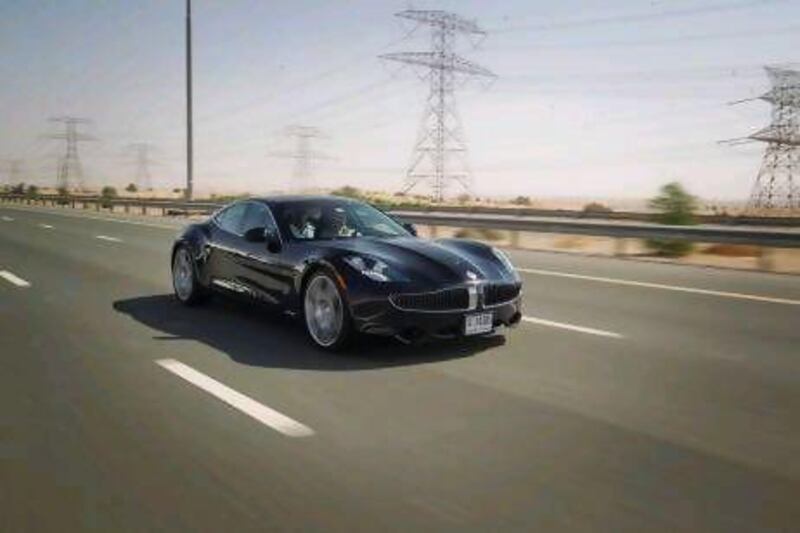It's my fault, I know, but I can't bring myself to judge a car by its own merits. The role of a critic is to compare, contrast and ultimately pass judgement on anything you care to mention, while looking to other examples in a particular field when coming to a decision. And, when it comes to cars, there are precious few out there that have no peers against which to be judged. I'm in a Fisker Karma, my right foot is flat on the floor and I'm feeling distinctly underwhelmed by its lack of accelerative punch. The Tesla Roadster, in comparison, felt like I was inside a bullet that had just been fired from a .44 Magnum.
It's no doubt down to the Karma's weight disadvantage (it tips the scales at a decidedly porky 2,402kg). But, lack of expected punch aside, this is one extremely impressive, and interesting, motor car. Let's leave the tech to one side for a moment, though, and check out the one element of this car that will undoubtedly appeal to buyers here in the UAE: its looks.
A low, wide and very long riot of curvaceous gorgeousness, the Karma looks good enough to eat. See one on the road and your jaw will drop, while dribble seeps down your chin, because (strange nose job notwithstanding) this is one of the world's most beautiful cars and looks even better on the move than when it's parked. Designed by the Danish man partly responsible for Aston Martin's DB9 and entirely responsible for the V8 Vantage, as well as BMW's much-maligned Z8, it was never going to be hit by the ugly stick. But, seriously, I haven't experienced a car that turns quite so many heads as this in Dubai - the city that's seen it all.
Despite the company's insistence, however, that the Karma was designed without compromise, the car is far from perfect. The boot space is practically nonexistent, for instance, and the rear quarters are so cramped that even an Aston Martin Rapide feels enormous in comparison (there I go again) and I, even at a relatively modest height of 1.78 metres, find my head is jammed up against the Karma's roof lining. I can't recall ever feeling claustrophobic inside a car, but this is enough to almost bring on a panic attack, not helped by the fact that, to open its doors, you have to press a button. I don't trust electronics to let me out of a car - a proper handle with an actual mechanical function that I can always rely on in case of an emergency would, I suspect, make me feel slightly less anxious.
So there have, indeed, been compromises when it comes to the Karma's design, which is hardly surprising, given what those sensuous curves have to house. Its aluminium space frame is host to a 260hp, four-cylinder, 2.0L GM engine; a generator; a 315-cell lithium-ion battery pack; two electric motors that, with the generator going, produce 403hp; three separate liquid-cooling systems and a roof-mounted solar panel. Having said that, there's ample room for front seat occupants, so best you view this as a two-seater rather than a family load-lugger.
Construction quality seems remarkably high for such a low volume, niche product. Although my test car did appear rather sombre in its colour combinations. The leather upholstery is "low carbon" and the timber trim is recycled. Problem is, it looks it, and I'd rather it wasn't there at all. Most of the driver's controls are housed within a dominant central touch screen, making for a clutter-free environment, and the layout is classy and sophisticated.
On the move, the Karma uses only electric power for the first 80 kilometres before the petrol engine kicks in, never allowing the battery pack to be depleted beyond 20 per cent of its capacity. Unlike other hybrids, however, the engine is not connected to the wheels. Rather, it drives the on-board generator, which sends electricity to the twin motors, which turn the wheels. There's hardly any mechanical interaction at all, which Fisker claims increases the Karma's inherent reliability. Time will tell if that's true or not, especially here in the UAE where extreme summer heat will no doubt take its toll on all those electrical systems. Still, at least there will be no shortage of sunshine to press that solar panel roof into service.
While I might appear somewhat ambivalent to the Karma's charms, there's joy to be had in the way this car handles. It corners flat and true, even when pressing hard, yet, the ride-comfort is sky high despite the huge rims and low profile tyres stretched around them.
All in all, a bit of a mixed bag, the Karma. It's expensive and possibly not worth the asking price, yet, that's precisely why it will probably sell in impressive numbers here. How long that will continue, we'll just have to wait and see. But mark my words, when you see one on the road, you will positively ache to own one. And that, for some of us, is all that matters.






